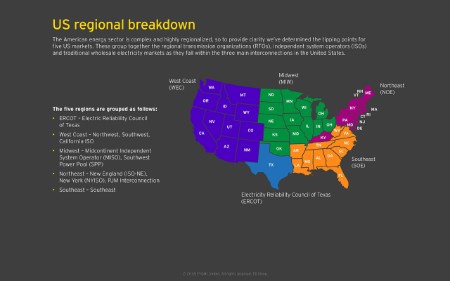

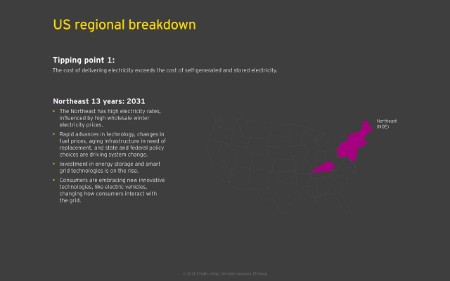
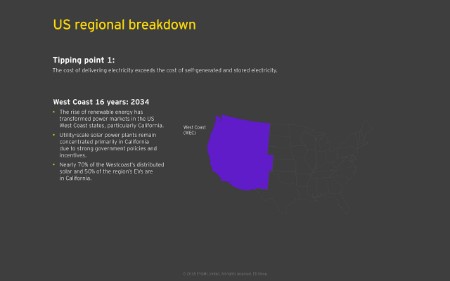
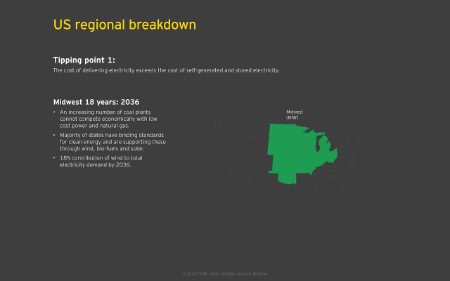
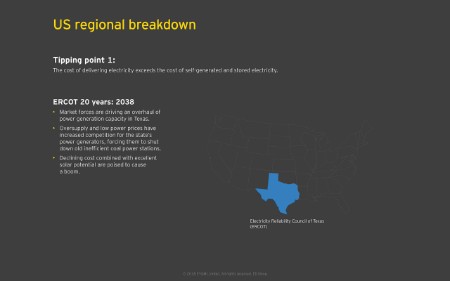



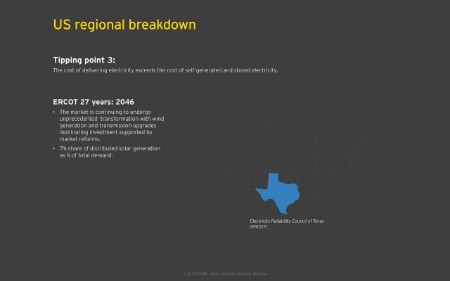
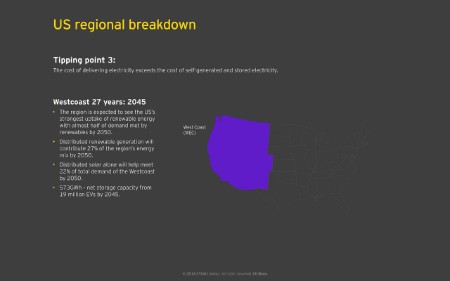

Why will disruption hit American markets much later?
The American energy sector is complex and highly regionalized, making it difficult to get one clear picture of what is driving change. But several common factors can help explain why the rise of DERs will impact US utilities at a slower pace than elsewhere:
Low coal, gas generation and utility-scale renewable costs
Wholesale power prices have fallen across all of the major US trading hubs, mostly because of sustained low costs of natural gas — the fuel that often determines the marginal generation cost in most power markets. Natural gas costs in the US are almost half that paid in Europe (US$2.5/MMBtu compared to $4.9/MMBtu), while coal in the US is just US$12 a ton compared to US$64 a ton in Europe. Such low fuel costs combined with the low-marginal cost of utility-scale renewables drive electricity prices lower. At these low prices, consumer pressure for change will come more slowly and grid price parity for distributed generation (DG) plus storage will take much longer to achieve.
Low taxes
One of the biggest factors behind lower energy prices in the US is a much lower rate of taxation compared to other regions.
- Taxes contribute only 5% of US retail electricity prices — compared to making up one-third of prices in Europe.
- In the US, generation costs make up 50%-60% of electricity retail prices compared to only 38% in Europe.
Lower transmission and distribution (T&D) costs
Over recent decades, US utilities have generally invested less (as a percentage of total capital spend) in the electricity grid compared to utilities in other developed regions of the world. This, along with a tendency to deploy overground poles and wires rather than the underground infrastructure used in much of Europe, has led to lower costs. But while years of lower T&D investment may have helped keep consumer energy bills lower in the past, this has changed in recent years. Several utilities have announced multibillion-dollar programs to modernize the grid and upgrade aging infrastructure over the next 5–10 years.
Accelerating technology and consumer demands could bring tipping points forward
But while grid parity for PV plus storage is expected to occur more slowly in the US compared to other countries, this first tipping point is only 13 years away for the US Northeast region. For an industry used to investment timelines that span 40 or 50 years, this is a compressed time frame in which to make big changes. And most US regions will experience all three tipping points in quick succession, leaving little room for adaptation once these changes come thick and fast.
Across the country, two factors could also bring tipping points forward:
- Accelerating technology: Advances in digital technology are increasing exponentially, creating new products and services that may transform energy use in a way we cannot even imagine today. At the same time, technology is continually improving the performance and reducing the cost of existing services and products such as solar PV generation and batteries.
- Consumer demand: While residential solar PV currently sits at just 1%, changing consumer attitudes toward renewable energy and the technology that supports it could see this figure rise quickly. Meanwhile, corporate consumers, including some of the world’s most influential companies are investing heavily in DG to take charge of energy bills and boost their “clean and green” reputations.
State-based initiatives will make the difference
The highly localized nature of the US energy market means that real change will be driven at a state or regional level. So while the federal government has withdrawn some support for renewables, increased clean energy initiatives at a state level may speed up progress toward tipping points in some areas.
For example, while California sits within the West Coast region — where tipping point 1 is expected in 2034 — we’ve modeled that the state will reach this milestone in just a decade. If other states are inspired to adopt some of California’s world-leading policies and programs around DER and electric vehicles, we may see more US “hotspots” of energy transformation emerge.
Related article
Time to prepare for a new energy world
It’s clear that DERs will play a critical role in shaping the future US energy market, with generation becoming more diverse, decentralized and enabled by a digital grid powered by automation and data-led intelligence.
To find out about how the generation mix is changing across the US, see the video below:
Those that stand the best chance of success in this new US energy sector are those taking action now to prepare. Now is the time for utilities to:
- Rethink investment priorities as the energy mix shifts. More renewables and natural gas generation will require appropriate grid upgrades and new capabilities, including digital technologies. Several major US utilities have announced investments in solar, smart meters, grid modernization and batteries.
- Leverage the potential of EVs: Modeling predicts that there will be 7m EVs in the US by 2025 — and 88m by 2050. With each EV holding up to 30KWh of battery storage, utilities should consider how this can be used to benefit consumers while strengthening and enhancing the grid.
- Learn lessons from other regions: US utilities could benefit from taking a more outward view to learn from energy companies in other regions that have already had to adapt to much higher market penetration rates of distributed generation, especially rooftop solar.
- Accelerate diversification to mitigate risk: Diversifying into natural gas, renewable generation and advanced energy storage now will position utilities to take advantage of a changing energy mix.
- Explore connections with corporate consumers with sustainability agendas: Opportunities to help corporate clients build and manage self-generation and storage facilities could be lucrative. Brokering power purchase agreements of off-site, large-scale wind and solar energy is another strong growth area.
- Consider collaborations with innovators in other industries: US utilities are already forming partnerships with companies in adjacent industries, such as battery manufacturers and technology firms, to enhance their capabilities in new energy services and develop innovative products and services.
- Get closer to regulators to shape new regulatory frameworks: Energy regulations lag the transformation of the sector. Different models of rewarding sector investment could help incentivize innovative new business models. In addition to New York’s REV, Illinois’s recent energy reforms that reward utilities for investing in distributed generation are expected to help shape new solar-based business models.
US utilities should seize opportunities of change
The US is a patchwork of regional differences in market structures, retail prices and resource availability. Each region is on its own path to transformation and now we’ve modeled the date on which US energy markets will change forever.
Now is the time to rethink investment strategies, innovate new business models, learn lessons from other regions and industries, and take a proactive role in the transformation of the utility sector.
Resumen
As the countdown to increasingly feasible grid defection by customers accelerates and a new distributed model emerges, American utilities can seize the opportunities that extra lead time allows them.

